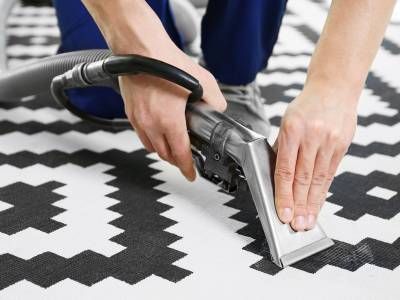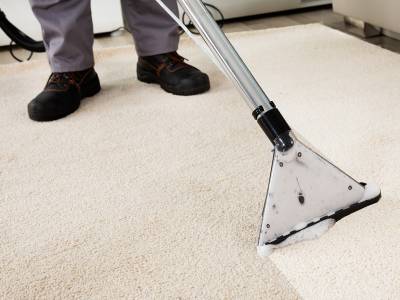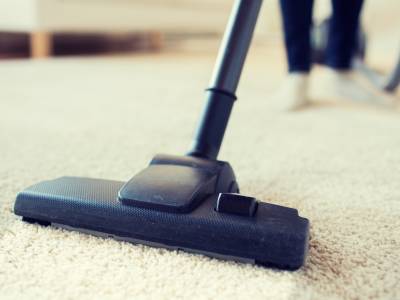Insects-so small you hardly notice them-may be doing damage to textile items around your home. Generally, you aren't aware of them until after the damage has been done. The babies are the culprits-eating their way through your wool rugs as they mature. Their mothers and fathers do no damage-except to leave behind their eggs from which the hungry larvae hatch.
Most people know that clothes moths can do considerable damage, but carpet beetles can cause extensive damage if they are not controlled. Clothes moth larvae are usually found on their food material. Carpet beetle larvae are more invasive and crawl from one room to another.
Habits
Mature insects deposit eggs in a variety of locations-clothing, upholstery, rugs or carpet, toys, animal skins or trophies, and even natural-bristle brushes. As the eggs hatch, the larvae begin to feed on animal-based materials: silk, wool, feathers, and leather. They also have been known to eat fabrics blended with wool and items soiled with food stains or body oils.
Eggs and larvae of moths and beetles can be carried into homes on articles containing wool or other animal fibers. Items such as secondhand furniture, upholstered furniture, and other home furnishings can be home for these pests. Clothes moth eggs or larvae also hide in woolen fabrics or rugs.
Adult clothes moths prefer darkness and quickly hide when they are disturbed. Clothes moths are not the moths seen flitting about lights. Adult clothes moths are about 1/2 inch long and light tan in color.
Adult carpet beetles are attracted to the sunlight and are known to feed outdoors on pollen of flowers. The most common adult carpet beetles are small, oval-shaped insects that are black with varied patterns of orange and white. They are sometimes mistaken for common garden lady beetles because of their similar size and shape.
Two types of clothes moths damage textile items. Casemaking clothes moth larvae (cream-colored caterpillars less than 1/2 inch long) spin protective cases incorporating pieces of the items they are eating. The cases, which they drag along as they move, eventually become tough cocoons in which the insect pupae develop into adult moths. Webbing clothes moths spin a silken web to form feeding tubes that they attach to the item being eaten.
Carpet beetle larvae (about 1/8-1/4 inch long and covered with hairs or bristles) do not spin webs or make cocoons. As they mature, they shed their skins, which look like living larvae. Carpet beetles crawl from place to place as they eat, but may be found in areas that do not provide any food. Fecal pellets are found where beetles have been feeding.
Clothes moth and carpet beetle larvae feed in quiet, dark areas-closets, attics, bureau drawers, storage trunks or boxes. Items that are stored for long periods are especially at risk. Such pests seldom infest items used on a regular basis. They do not damage rugs and carpets in regular traffic areas or where routinely vacuumed. Areas next to the wall or under furniture are likely targets for these hungry insect larvae.
Preventing and Controlling Infestation
To prevent infestation by clothes moths and carpet beetles, practice good housekeeping. If carpets and rugs are vacuumed frequently and thoroughly, eggs and larvae will be removed before damage can occur. Pet hair is a food source for moth and beetle larvae – wash and groom pets regularly and inspect animal’s coats.
Vacuum and inspect rugs and upholstered furniture 1-2 times/week and schedule professional cleaning yearly.
Clothing and other textile items should be stored only if clean. Storage areas should be kept clean. Vacuum the floors, shelves, and walls to remove dust, webs, and any inconspicuous eggs or pesky insect larvae.
Clothing and other textile items can be protected by storing them in tight-fitting containers or carefully sealed boxes with a moth repellent. The vapors of the repellent are lethal to fabric pests only if they are maintained at sufficient concentrations for a sufficient amount of time. Follow the manufacturer's instructions carefully. Generally, two to three weeks of treatment will ensure absolute kill of all stages of insect pests-egg, larva, pupa, and adult.
After storage, air items for a few days before using them to get rid of any odor. If items are washable, launder them before using.
If you find that your home has an infestation of clothes moths or carpet beetles, remove all items from the infested area carefully. Vacuum the areas thoroughly and wash surfaces that have been in contact with infested items. Be careful not to contaminate other areas of your home.
If an insecticide is to be used in the infested area, read and follow instructions for its use carefully. If a spray is used, apply it to cracks and crevices and infested areas only. Do not spray walls and shelves. If carpet is infested, it can be sprayed, especially along baseboards and under furniture.
DO NOT directly spray clothing or bedding with an insecticide. Remove all clothing, shoes, and other items from a closet or piece of furniture before the insecticide is applied.
Before returning items to areas that were infested, launder or dry-clean them. Both laundering in hot water and dry-cleaning will kill all stages of fabric pests. Cleaning also will remove food stains or body oils, which attract insects. Brushing and sunning items will help to rid them of eggs and larvae. Brush items outdoors to prevent infestation of other items.
If items were heavily infested, it may be best to discard them to avoid re-infesting the area. Then watch the area to be sure there is no damage to stored items.
Cedar-lined closets and cedar chests can help prevent infestation if they can be sealed tightly. After several years, however, the volatile oils that provide the protection may dry up and no longer be effective.
Freezing can be used as a method to control fabric pests. To be effective, store items at 0°F for a minimum of 48 to 72 hours. Kill can be achieved at 10°F, but the items must be stored much longer. This method works best for small items such as stuffed animals, feather accessories, or items difficult to launder or dry-clean.
When freezing items, place them in polyethylene bags, squeeze out excess air, and seal tightly. After the prescribed amount of time in the freezer, remove the item to the refrigerator to thaw slowly. Items can be removed from the bag after coming to room temperature. Or store the items in the polyethylene bag. To guarantee a complete insect kill, it is recommended that you immediately repeat the process before removing contents from the bag.









